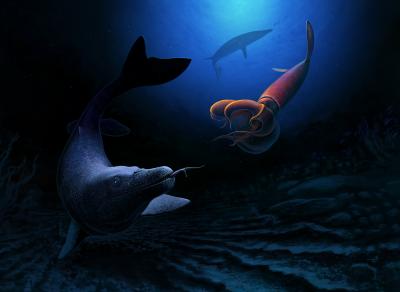
Credit: Andrey Atuchin
A giant mosasaur from the end of the Cretaceous period in Morocco that could have reached up to eight metres long is the third new species to be described from the region in less than a year, bringing the total number of species up to at least 13.
The high diversity of the fauna shows how mosasaurs, giant marine lizards related to snakes and Komodo dragons, thrived in the final million years of the Cretaceous period before they, and most of all species on Earth, were wiped out by the impact of a giant asteroid 66 million years ago.
The new species, named Pluridens serpentis, had long, slender jaws with over a hundred sharp, fanglike teeth to grab small prey like fish and squid. Compared to related species, it had small eyes, suggesting poor vision. But the snout had dozens of openings for nerves, hinting at the ability to hunt by sensing water movements and changes in pressure. These nerves may have been sensitive to tiny variations in water pressure, an adaptation seen in sea snakes.
“Typically, when animals evolve small eyes, it’s because they’re relying more heavily on other senses,” said Dr Nick Longrich, senior lecturer at the Milner Centre for Evolution at the University of Bath, who led the study.
The fact that Pluridens had so many nerves in the face may mean that it was using changes in water pressure to detect animals in low-light conditions, either at night or in deep, dark water. Mosasaurs may also have had other senses at their disposal.
“If it wasn’t using the eyes, then it’s very likely that it was using the tongue to hunt, like a snake,” he said. “Many aquatic snakes and lizards – sea snakes, filesnakes, water monitors- flick their forked tongues underwater, using chemical cues to track their prey. Mosasaurs would have resembled whales and dolphins, so it’s tempting to assume they lived like them.
“But they’re very different beasts – they’re huge lizards – so they probably acted like them.”
While most of its relatives were small, just a few meters long, Pluridens got big, perhaps eight meters long. The largest individuals had thick, heavily built jawbones.
“It’s possible that big males were fighting with these jaws,” said Dr Longrich. “In some beaked whales, the males have massive jaws they use to fight with, and male sperm whales can be highly aggressive. Some Pluridens jaws show healing injuries, which suggests some violent fights.”
The Moroccan mosasaurs were wildly diverse. Some had small teeth for seizing fish and squid, others evolved blunt teeth to crush crustaceans, clams, and ammonites, while others had teeth designed to cut or tear apart other marine animals – including other mosasaurs.
Pluridens brings the number of mosasaurs known from latest Cretaceous of Morocco up to 13, but the researchers suggest it’s unlikely to be the last new species.
Dr Longrich said: “The diversity in these fossils is just astonishing. Far from declining in diversity, the mosasaurs seem to be peaking just before they went extinct.
“We’re not seeing any evidence that this group was struggling before they went extinct – From an evolutionary standpoint, they were succeeding, they did everything right- but nothing can prepare you for an asteroid.”
Co-author on the study, Dr Nour-Eddine Jalil from the Natural History Museum of Sorbonne University (France) said: “It’s a new species of a large predator which, with its eight metre length, comes to confirm the diversity of the faunas of the seas just before the Cretaceous crisis.
“Pluridens serpentis highlights the importance of the paleontological heritage of Morocco to help illustrate the history of life.”
Dr Nathalie Bardet, a specialist in mosasaurs, particularly those from the Phosphates of Morocco, at the Muséum National d’Histoire Naturelle of Paris, was also co-author on the paper.
She said: “Working on this group of marine reptiles since more than 20 years, I never stop being surprised by the incredible diversity of these predators, who all lived there and shared the available space and food resources.
“These latest discoveries show perfectly that the list of species present here is far from being closed and that the future still holds great surprises and discoveries!”
###
The study, done in collaboration with researchers from Natural History Museum of Sorbonne University (France), the Office Chérifien des Phosphates (OCP) and University Cadi Ayyad (Morocco), is published in Cretaceous Research.
Media Contact
Vicky Just
[email protected]
Original Source
https:/
Related Journal Article
http://dx.




